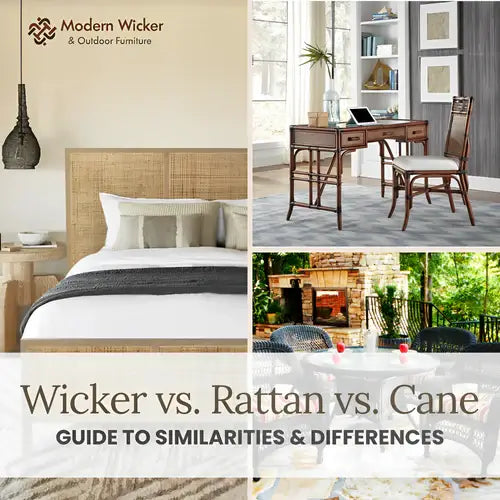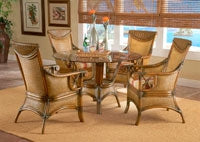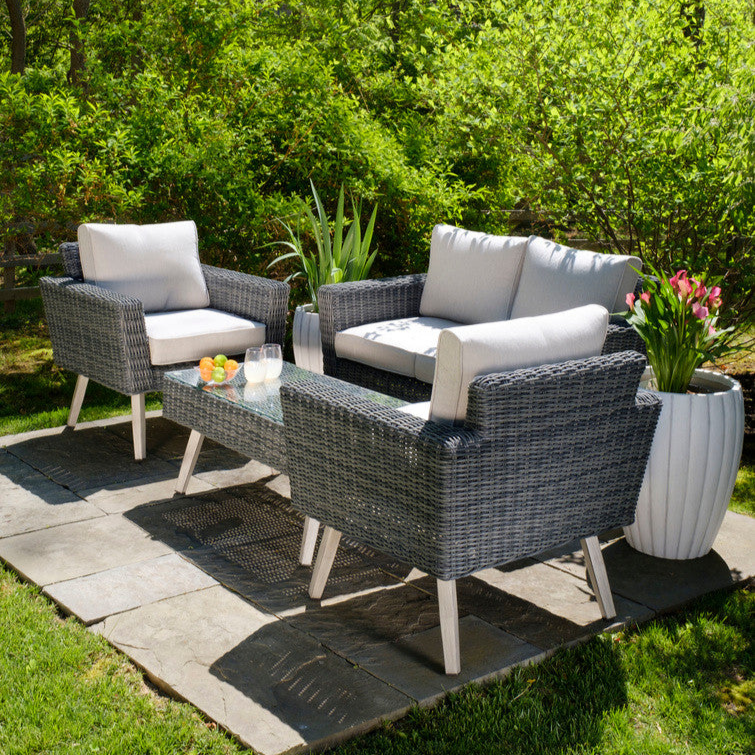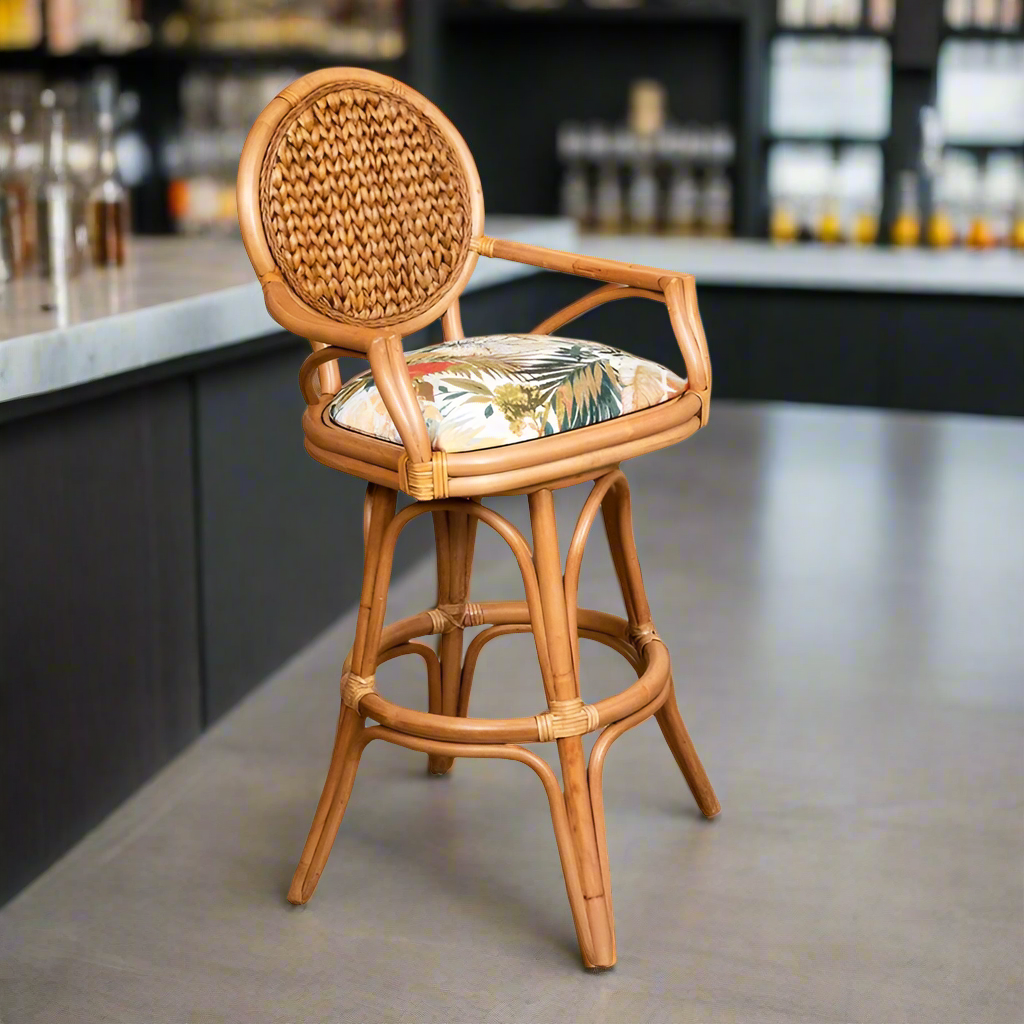Hand-woven textures with an earthy, organic aesthetic appeal to everyone. The ancient art of weaving has joined contemporary home décor trends. These trends favor natural and eco-friendly materials for furniture making.
Rustic, wicker-inspired themes fill most designers’ and homeowners’ Pinterest feeds today. Such hand-woven furniture offers many benefits, such as easy-to-adapt styles, lightweight properties, and an elegant, timeless appeal.
Wicker, rattan, and cane are common elements of this type of furniture. They can change the game in both indoor and outdoor spaces.
But are they all the same?
Let’s explore each one and find out the differences between wicker vs. rattan vs. cane furniture.
Rattan vs. Wicker vs. Bamboo: Our Product Recommendations
Looking for the best rattan, wicker, or bamboo furniture for your indoor or outdoor space? We recommend the following products that can enhance the beauty and aesthetics of your chosen space.
Rattan Bermuda Indoor Sofa

It doesn’t get more rustic than having organic, rattan-pole furniture in your living room. This South Sea Rattan Bermuda Indoor Sofa will add an earthy touch to your living space. The lovely rattan weave design and leather wrapping combine to produce a curved silhouette reminiscent of classic furniture.
Aside from its timeless appeal, the sofa has a scratch-resistant finish which can withstand daily dings and bumps. The luxurious cushions on the sofa are available in various materials, colors, and patterns.
This rattan furniture also has the following features:
- Fully assembled furniture
- Made of hardy organic rattan and rattan peel for durability
- Non-marking furniture feet to prevent floor scratches
- Ideal for indoor use
Dimensions:
75" W x 34" D x 33" H
Wicker Loveseat

This classic loveseat from the Martinique Collection exudes elegance and comfort. The Verona Wicker Loveseat by Lloyd Flanders preserves all of the natural appeal of wicker while dressed in a clean, modern design. Its fine weave and moderate scale design indicate high quality and comfort.
This comfy loveseat draws attention to any indoor space, made from heirloom-quality natural fiber wicker that will last for years. For longevity, the natural wicker comes with a high-quality Durium polyester coating.
The loveseat comes with luxurious and comfortable cushions, but you can customize it with fabrics and patterns.
This wicker furniture’s other features include:
- Lloyd Loom® finish
- Made from pliable, 100% virgin vinyl that won’t lose shape
- UV-resistant coating to prevent fading
- Continuous wicker weave to avoid cracking
- Anti-corrosive aluminum frames
- Minimal maintenance & highly durable
- Hypoallergenic, mold-resistant cushioning
- All-weather wicker
Dimensions:
67"W x 31.5"D x 29"H
Bamboo & Rattan Polynesian Swivel Barstool

This vintage-inspired swivel barstool combines the best of all three materials for a durable outdoor accessory you’ll be able to love for years. This barstool is part of the Polynesian collection and is made from herringbone wicker, bamboo, and fine rattan materials.
A dark, coffee-brown varnish gives it a rich, antique look. Comfortable beige upholstery adds a striking contrast. You can choose from a collection of 35 colors and fabrics. Besides the high-stool design and aesthetic tropical island motif, the barstool has a swivel design for maximum comfort.
Other features include:
- Long-lasting construction
- Wicker weave and Rattan poles
- One-year warranty against rattan frame defects
Dimensions:
22"L x 23"W x 45"H
Wicker vs. Rattan vs. Cane: Understanding the Basics
Wicker, rattan, and cane, while they are used interchangeably, are not the same.
Deciphering the differences between wicker, rattan, and cane can seem like a "chicken-and-egg" problem, but not to worry! We go over each material and process in detail.
What is Wicker?
Many people mistake wicker as a material, similar to rattan or cane. But wicker pertains to a notable weaving technique. The term 'weaving' refers to natural materials and fibers obtained from plants.
The strands of these long vines are peeled, stacked, and braided to make furniture. Wicker is the umbrella term for hand-woven furniture, while rattan, and cane are the actual materials used in this process. Today, cane and rattan aren’t the only materials used in wicker furniture making.
Wicker furniture is also made of other natural materials such as:
- Reed
- Seagrass
- Water hyacinth
- Bamboo
- Willow
Natural wicker furniture has a rustic charm, making it a popular choice for indoor spaces.
The advantages of natural wicker furniture include:
- Sturdy and durable (natural wicker can last over a decade!)
- Lightweight and easy to move
- Adaptable to diverse design styles
- Luxurious appeal
- Mold- and mildew-resistant
- Eco-friendly
- Easy to maintain
While natural wicker is a bold indoor furniture choice, it doesn’t perform as well outdoors. Natural fibers cannot withstand external elements, deeming them ineffective in the face of rain, sun, and humidity. Outdoor wicker furniture employs synthetic materials for this process.
Outdoor wicker furniture uses materials such as:
- Resin
- Polyethylene (PE)
- Vinyl
- High-density Polyethylene (HDPE)
Synthetic wicker is sustainable and provides many of the same benefits as natural wicker. The added benefit is that it can survive outside in its weatherproof avatar.
What is Rattan?
Rattan is a type of palm that thrives in tropical locations all over the world. Its untamed and resilient qualities make it an excellent material for furniture construction. It can grow over 300 feet long and regrow in a few years after being harvested. It is one of the world's fastest-growing materials, second only to willow.
The beauty of rattan is in its distinct layers, each of which can be used to construct furniture. The term rattan alludes to the plant's robust outer layer. It has a dense, fibrous structure, making it hardy and flexible.
Its sturdy design keeps it from collapsing under adult human weight while preserving its original shape.
Synthetic rattan wicker offers many of the benefits mentioned above and is one of the materials that can also withstand the outdoors. Rattan furniture is used in atriums and patios that receive a lot of sunlight.
Types of Rattan: Synthetic, Himalayan, & Reed
Wicker furniture uses natural and synthetic rattan, noted for its hardy properties and flexible nature. Let’s explore the different types of rattan used by wicker manufacturers.
Synthetic Rattan
Many think anything with the word “synthetic” is bad for the environment, but it cannot be further from the truth when it comes to synthetic rattan. Synthetic rattan is made from PE or polyethylene and a sustainable material mirroring natural rattan's rustic beauty and timeless appeal.
Synthetic rattan can survive all types of weather and outdoor elements, including:
- Dust
- Moisture
- Mold/mildew
Sunlight and rain won’t damage synthetic rattan. Natural rattan, while original and desirable, contains natural fibers that degrade in sunlight and rain.
Himalayan Rattan
Himalayan Rattan is a hardy rattan originating from India's Himalayan mountain region. This variety of rattan, derived from a plant that flourishes in the harshest conditions, can survive extreme temperatures, including snow.
While it would have been an excellent choice for long-lasting, weatherproof furniture, its soft pith renders it too malleable to sustain heavy weight. It is used to create sacred Himalayan artifacts such as singing bowls.
Reed Rattan
Reed refers to the innermost portion of the rattan palm plant. Its texture is similar to wood and is more amenable to staining than cane. It is also denser and has tighter fibers that last longer on wicker furniture.
Although it is not utilized to make whole furniture frames, it is an attractive decorative feature in wicker furniture. It can absorb stains and be painted to meet décor requirements. When treated with varnish, rattan preserves its original hues and does not fade for years.
What is Cane?
Cane is a part of the rattan palm plant. When the rattan exterior of the palm plant comes off, it leaves behind a reed-like interior known as cane. Its long, malleable form is ideal for producing various pieces of furniture, including wicker.
Cane’s intricate weave is iconic and instantly recognizable. Despite its flexibility, it cannot absorb paints and stains well, which is why you see cane furniture in its natural, rustic color.
Rattan vs. Wicker vs. Cane: Durability
Rattan, cane, and wicker furniture are long-lasting and can last 10 to 20 years if properly cared for.
Cane
Cane furniture is intended for indoor use. It can endure for a decade or two if kept indoors and maintained well (with gentle cleaning). Its naturally tough fibers can survive regular wear and tear while maintaining shape. That said, the severe heat and rain can wreak havoc on cane furniture, rendering it unsuitable for use on an outdoor patio.
Rattan
Rattan is more adaptable than cane when discussing durability and outdoor use. Natural rattan is a classic material with strong strands lasting for decades. Rattan furniture can be used inside and outside, though outdoor rattan furniture requires special care.
It requires a lacquer coating to protect it from moisture. Synthetic rattan furniture made of PE or polyethylene will endure longer outside, come sun or rain.
Synthetic Wicker
When it comes to durable outdoor furniture, synthetic wicker outdoor furniture is your best bet. Synthetic wicker, produced from high-quality resin wicker, such as HDPE (high-density polyethylene), can last for decades, even when stored outside.
It is the finest choice for patio furniture because its synthetic fibers are waterproof. It does require moderate care every few months, but it can withstand the elements far better than any other material.
Synthetic wicker patio furniture is also versatile. It can blend well with any setting, whether it’s a leafy garden patio or a breezy seaside setup. Its all-weather resin wicker construction protects it from salt and chlorine damage, ensuring a longer lifespan.
Wicker vs. Rattan vs. Cane: Final Words
You might feel confused by rattan vs. wicker vs. cane. They’re different but related, and you can easily learn their purpose and role in furniture making.
To recap:
- Wicker is a term for a weaving process.
- Rattan is a strong material with a flexible and long-lasting composition.
- Cane is the inner part of a rattan plant.
If you’re looking for patio furniture, synthetic rattan is the best choice for you. Synthetic rattan wicker surpasses cane and natural wicker in weather resistance.
You also want to pick high-quality pieces that will last decades for your wicker furniture. You can rely on Modern Wicker, a trustworthy and reputable retailer, for your patio wicker furniture.
Modern Wicker has a wide range of wicker seating and dining sets, as well as accessories and standalone wicker pieces. And the best part? We deliver for free!
Check our website for more details or get in touch. Our staff will gladly assist you with anything you need.







